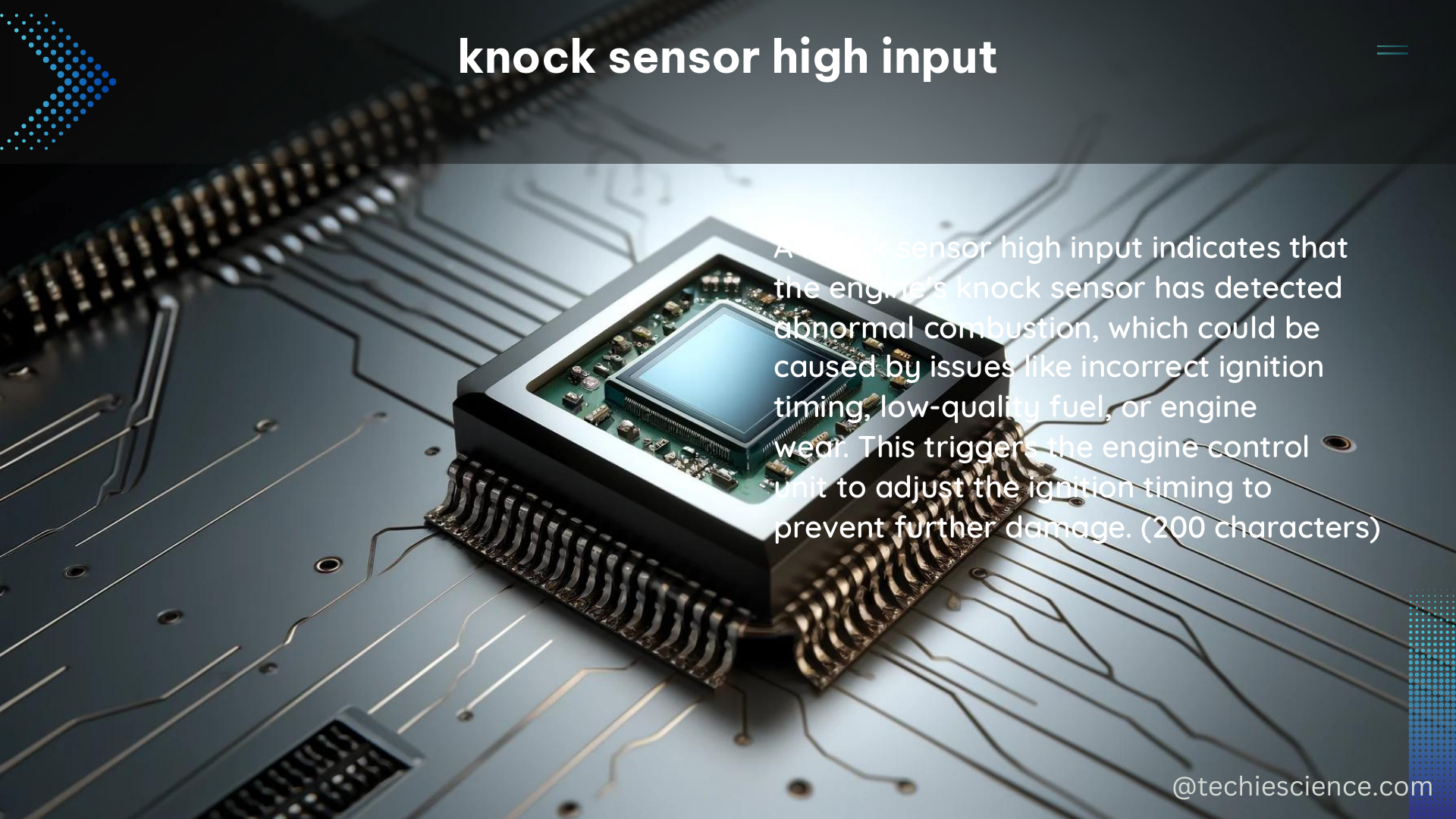Knock sensors are critical components in internal combustion engines, responsible for detecting engine knocking or pinging, which can lead to severe engine damage if left unchecked. When a knock sensor experiences a high input signal, it’s essential to understand the underlying causes, technical specifications, and troubleshooting techniques to maintain optimal engine performance.
Understanding Knock Sensor High Input
Knock sensors measure the vibrations produced by engine knocking and send a signal to the engine control module (ECM) to adjust the ignition timing and fuel injection, preventing further engine damage. A high input signal from the knock sensor typically indicates excessive engine knocking or pinging, which requires immediate attention.
Technical Specifications of Knock Sensors

Sensitivity
The sensitivity of a knock sensor is a crucial specification, measured in millivolts per knock per second (mV/knock/s). This value represents the amount of voltage the sensor produces in response to a given level of engine knocking. A higher sensitivity value indicates a more sensitive knock sensor that can detect lower levels of engine knocking.
For example, a knock sensor with a sensitivity of 20 mV/knock/s would produce a 20 millivolt signal for every knock detected per second, while a sensor with a sensitivity of 30 mV/knock/s would produce a 30 millivolt signal for the same level of knocking. The higher the sensitivity, the more responsive the sensor is to engine vibrations.
Frequency Response
The frequency response of a knock sensor is measured in hertz (Hz) and indicates the range of frequencies the sensor can detect. A wider frequency response allows the sensor to identify a broader spectrum of engine knocking frequencies, providing more comprehensive monitoring of the engine’s condition.
Typical knock sensor frequency responses range from 5 kHz to 20 kHz, with higher-end sensors capable of detecting frequencies up to 30 kHz. The wider the frequency response, the more accurate the sensor’s ability to identify the source and characteristics of engine knocking.
Diagnosing and Troubleshooting Knock Sensor High Input
When a knock sensor experiences a high input signal, it’s essential to diagnose and troubleshoot the issue to prevent further engine damage. Here are some common techniques and tools used for this purpose:
Oscilloscope Measurement
Using an oscilloscope, you can measure the voltage signal produced by the knock sensor and analyze its waveform. This can help identify any abnormalities or irregularities in the signal, which may indicate the root cause of the high input, such as sensor malfunction, wiring issues, or excessive engine vibrations.
Engine Diagnostic Software
Many modern vehicles are equipped with engine diagnostic software that can analyze the data from the knock sensor and provide recommendations for corrective action. This software can help pinpoint the specific issue causing the high input and suggest appropriate solutions, such as adjusting the ignition timing, addressing fuel injection problems, or replacing the knock sensor itself.
Visual Inspection
A thorough visual inspection of the knock sensor and its associated wiring can also reveal potential issues. Look for signs of damage, corrosion, or loose connections that may be contributing to the high input signal.
Practical Considerations
In addition to the technical specifications and troubleshooting methods, there are several practical considerations to keep in mind when dealing with knock sensor high input:
-
Engine Condition: A high knock sensor input may indicate an underlying issue with the engine, such as carbon buildup, worn piston rings, or incorrect fuel octane. Addressing these root causes is essential to prevent further engine damage.
-
Ignition Timing Adjustment: When the knock sensor detects excessive knocking, the ECM will typically adjust the ignition timing to reduce the knock. However, if the knock sensor input remains high, the ECM may not be able to compensate effectively, requiring further investigation and adjustment.
-
Fuel Injection Optimization: The ECM may also adjust the fuel injection parameters in response to a high knock sensor input, but if the issue persists, the fuel injection system may need to be inspected and optimized.
-
Sensor Replacement: If the knock sensor itself is malfunctioning or damaged, it may need to be replaced to restore proper engine operation and prevent further issues.
By understanding the technical specifications, diagnostic techniques, and practical considerations surrounding knock sensor high input, you can effectively troubleshoot and resolve this common engine issue, ensuring optimal engine performance and longevity.
References:
- Intracellular cAMP Sensor EPAC: Physiology, Pathophysiology, and Pharmacology
https://www.ncbi.nlm.nih.gov/pmc/articles/PMC6050347/ - Check and change ABS and wheel speed sensors
https://www.hella.com/techworld/us/Technical/Sensors-and-actuators/Check-change-ABS-sensor-4074/ - Administrative Changes to AETC TTP11-1, Employment of the F-15 Eagle
https://static.e-publishing.af.mil/production/1/aetc/publication/aetcttp11-1/aetcttp11-1.pdf - Robots With Flawed AI Make Sexist And Racist Decisions
https://www.reddit.com/r/science/comments/vmepss/robots_with_flawed_ai_make_sexist_and_racist/ - I got in trouble for using a mouse jiggler … despite my excellent work
https://www.askamanager.org/2023/01/i-got-in-trouble-for-using-a-mouse-jiggler-despite-my-excellent-work.html

The lambdageeks.com Core SME Team is a group of experienced subject matter experts from diverse scientific and technical fields including Physics, Chemistry, Technology,Electronics & Electrical Engineering, Automotive, Mechanical Engineering. Our team collaborates to create high-quality, well-researched articles on a wide range of science and technology topics for the lambdageeks.com website.
All Our Senior SME are having more than 7 Years of experience in the respective fields . They are either Working Industry Professionals or assocaited With different Universities. Refer Our Authors Page to get to know About our Core SMEs.